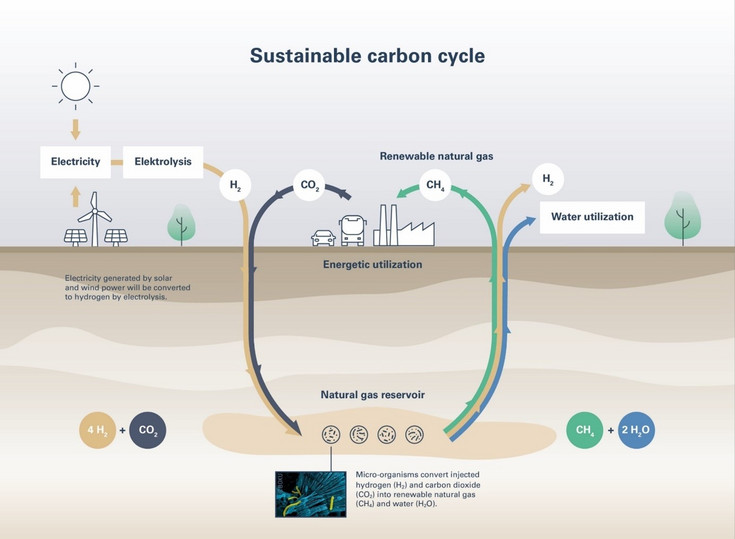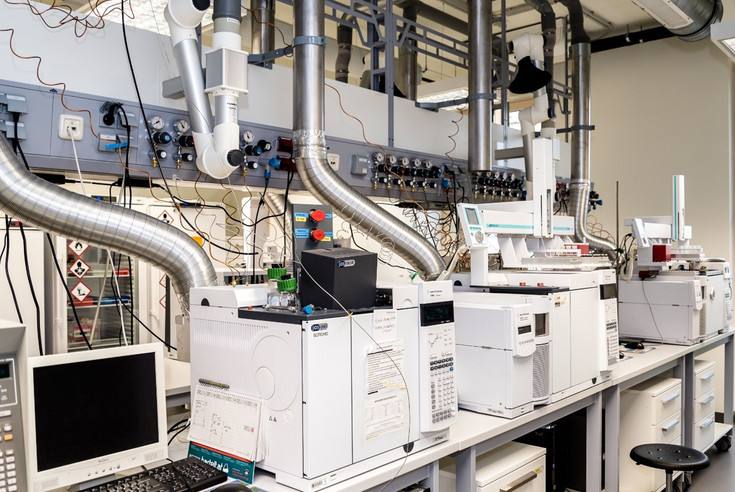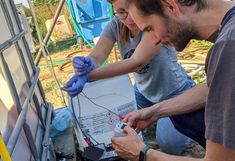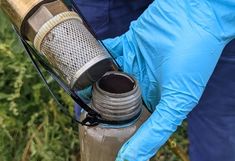Areas of expertise
Deep subsurface microbiology: Microbial processes for energy conversion and storage
The increasing production of electrical power from renewable energy sources, aimed to mitigate the effects of climate change, poses novel challenges, such as the large-scale storage of energy. Using the “power-to-gas” approach, renewable electricity may be converted into molecular hydrogen, a potent energy carrier gas, which can be stored in depleted natural gas reservoirs. Naturally, molecular hydrogen serves an energy source for numerous microorganisms native to these reservoirs. Consumption of hydrogen by microorganisms may lead to net energy losses and detrimental effects on the integrity of the storage facilities, which constitutes a central area of research in our working group.
At the same time, hydrogen gas along with industrial carbon dioxide may deliberately be converted to renewable methane, another potent energy carrier, by a microbially-mediated processes called hydrogenotrophic methanogenesis. Unlike molecular hydrogen, methane is fully compatible with the established energy system infrastructure. Moreover, methane produced via this technology, termed geo-methanation, is not only “green”, but is also “carbon-neutral”, since a closed-carbon cycle can be established.
In our laboratories, bioreactors, which can be operated at high pressure and temperature, are used to simulate the “extreme” conditions, that are typical for deep underground gas reservoirs. This allows us to study and develop an understanding of the underlying microbial interactions affecting geo-methanation. Furthermore, we focus on the development of engineering solutions and technical recommendations for industrial-scale implementation and optimization of the geo-methanation technology.
Our expertise in the investigation of environmental microbial processes is currently applied to several flagship projects of the Austrian Climate and Energy Fund, namely Underground Sun Storage 2030, Underground Sun Conversion - FlexStore and Carbon-Cycle Economy Demonstration. Further information on this projects can be found on: https://www.uss-2030.at/, https://www.underground-sun-conversion.at/flexstore, and https://www.rag-austria.at/forschung-innovation/carbon-cycle-economy-demonstration.

Schematic illustration of geo-methanation: Green hydrogen and industry-derived carbon dioxide can be injected into porous underground gas reservoirs and converted to renewable methane via microbial activity.
Soil pollution, environmental chemistry and microbial processes in contaminated soil
Anthropogenic contamination of soils is a major environmental issue of our modern world. In our lab, we couple the development and application of highly sensitive analytical chemistry methods with the investigation of microbial processes in contaminated soil to address numerous questions related to environmental pollution. Furthermore, fundamental sorption mechanisms of hydrophobic organic compounds are investigated with respect to their impact on microbial degradation and the toxicity of environmental pollutants.

Pollutant partitioning and sequestration
In the research field of pollutant partitioning and sequestration in soil, we develop methods such as the contaminant trap, sorptive bioaccessibility extraction (SBE) and passive dosing techniques in cooperation with international partners. These methods are applied to quantify the accessible pollutant share in soils and to determine the chemical activity of soil contaminants.

Microbial degradation of pollutants in soil
Native soil microbes are able to utilize an extremely wide range of chemical compounds for growth and harnessing of energy. This knowledge can be exploited to develop strategies for the optimization of microbial degradation of diverse environmental pollutants, most prominently hydrocarbons, in soil and subsurface environments. In our lab, we investigate the potential of diverse groups of soil microbes to degrade specific pollutants by analyzing shifts in microbial community compositions, metabolic profiles and ecological interactions between microbial community members in response to contaminant introduction. On this basis, we develop practical solutions and recommendations for successful field application of decontamination strategies.


